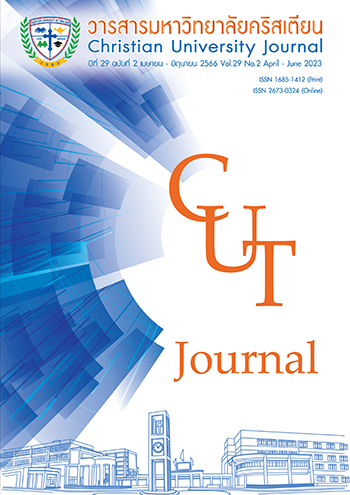การประเมินและการวิเคราะห์ตัวแปรจลนศาสตร์และเวลาของการปั่นล้อวีลแชร์ เพื่อประยุกต์ใช้ในงานฟื้นฟูและการกีฬา
คำสำคัญ:
วีลแชร์, จลนศาสตร์การปั่นล้อ, ตัวแปรเวลา, การฝึกทักษะการปั่นล้อบทคัดย่อ
การฝึกทักษะการปั่นวีลแชร์ทั้งในผู้ป่วยและนักกีฬาวีลแชร์ที่มีประสิทธิภาพต้องอาศัยการวิเคราะห์รายละเอียดของตัวแปรจลนศาสตร์และตัวแปรเวลา โดยตัวแปรจลนศาสตร์สามารถบ่งบอกถึงปริมาณและคุณภาพของการออกแรงที่กระทำต่อวงล้อ และการถ่ายทอดแรงไปยังดุมล้อเพื่อทำให้ล้อขับเคลื่อน ตัวแปรเวลาถูกใช้ทางคลินิกเพื่อแสดงรูปแบบการปั่นและรอบการปั่นล้อที่เหมาะสม ดังนั้นตัวแปรจลนศาสตร์และเวลาจึงแสดงถึงประสิทธิภาพการใช้พลังงานและงานของการปั่นล้อที่เกิดขึ้น และบ่งชี้ถึงความเสี่ยงต่อการบาดเจ็บของกล้ามเนื้อรยางค์แขน การวิเคราะห์ตัวแปรทั้งสองกลุ่มจึงมีความสำคัญต่อความสำเร็จของการฟื้นฟูและความสามารถของการปั่นล้อของทั้งผู้ป่วยและนักกีฬาวีลแชร์ บทความนี้มีวัตถุประสงค์เพื่อเน้นย้ำความสำคัญของตัวแปรจลนศาสตร์และเวลา และการวิเคราะห์เพื่อประยุกต์ใช้ทางกีฬาและทางคลินิก เพื่อพัฒนาทักษะการปั่นล้อให้มีประสิทธิภาพสูงสุดและลดความเสี่ยงของการบาดเจ็บที่เกิดจากการใช้งานมากจนเกินไป
เอกสารอ้างอิง
กระทรวงการพัฒนาสังคมและความมั่นคงของมนุษย์. (2564). รายงานข้อมูลสถานการณ์ด้านคนพิการในประเทศไทย. สืบค้นจาก https://dep.go.th/images/uploads/files/Situation_dep64.pdf
ธฤษณุวัชร ไชยโคตร. (2565). ความสำคัญทางคลินิกของการเปลี่ยนแปลงตามวัยทางชีวกลศาสตร์ ของการปั่นเก้าอี้ล้อในผู้สูงอายุ. วารสารมหาวิทยาลัยคริสเตียน, 28(2), 175-194.
สำนักงานสถิติแห่งชาติ. (2563). การสำรวจความพิการ พ.ศ. 2560. สืบค้นจาก http://www.nso.go.th/site/2014en/Survey/social/SocialSecurity/Disabilitysurvey/2017/Full_Report.pdf
Cavallone, P., Vieira, T., Quaglia, G., & Gazzoni, M. (2022). Electomyographic activities of shoulder muscles during Handwheelchair. Q vs pushrim wheelchair propulsion. Medical Engineering & Physics, 106(1), 103833.
Chaikhot, D., Reed, K., Petroongrad, W., Athanasiou, F., van Kooten, D., & Hettinga, F. J. (2020). Effects of an upper-body training program involving resistance exercise and high-intensity arm cranking on peak handcycling performance and wheelchair propulsion efficiency in able-bodied men. The Journal of Strength & Conditioning Research, 34(8), 2267-2275.
Chaikhot, D., Taylor, M. J., & Hettinga, F. J. (2018). Sex differences in wheelchair propulsion biomechanics and mechanical efficiency in novice young able-bodied adults. European Journal of Sport Science, 18(5), 650-658.
Cowan, R. E., Boninger, M. L., Sawatzky, B. J., Mazoyer, B. D., & Cooper, R. A. (2008). Preliminary outcomes of the smartwheel users’ group database: A proposed framework for clinicians to objectively evaluate manual wheelchair propulsion. Archives of Physical Medicine and Rehabilitation, 89(2), 260-268.
Fullerton, H. D., Borckardt, J. J., & Alfano, A. P. (2003). Shoulder pain: a comparison of wheelchair athletes and nonathletic wheelchair users. Medicine and Science in Sports and Exercise, 35(12), 1958-1961.
Heyward, O. W., Vegter, R. J., De Groot, S., & Van Der Woude, L. H. (2017). Shoulder complaints in wheelchair athletes: A systematic review. PloS One, 12(11), e0188410.
Hers, N., Sawatzky, B.J., Sheel, A.W. (2016). Age-related changes to wheelchair efficiency and sprint power output in novice able-bodied males. Ergonomics, 59(2), 291-297.
Leaman, J., & La, H. M. (2017). A comprehensive review of smart wheelchairs: past, present, and future. IEEE Transactions on Human-Machine Systems, 47(4), 486-499.
Lenton, J. P., van der Woude, L. H. V., Fowler, N. E., Nicholson, G., Tolfrey, K., & Goosey-Tolfrey, V. L. (2013). Hand-rim forces and gross mechanical efficiency at various frequencies of wheelchair propulsion. International Journal of Sports Medicine, 34(2), 158-164.
Mason, B., Lenton, J., Leicht, C., & Goosey-Tolfrey, V. (2014). A physiological and biomechanical comparison of over-ground, treadmill and ergometer wheelchair propulsion. Journal of Sports Sciences, 32(1), 78-91.
Rankin, J. W., Richter, W. M., & Neptune, R. R. (2011). Individual muscle contributions to push and recovery subtasks during wheelchair propulsion. Journal of Biomechanics, 44(7), 1246-1252.
Vanlandewijck, Y., Theisen, D., & Daly, D. (2001). Wheelchair propulsion biomechanics. Sports Medicine, 31(5), 339-367.
Vasquez, S. G., D’Innocenzo, M. E., Pearlman, J., Zigler, C., Mendez, Y. G., Rozen, P. & Praptoraharjo, I. (2020). Wheelchair user’s voice: A pilot study in Indonesia. bioRxiv. [pre-print] doi: https://doi.org/10.1101/2020.01.16.908772.
Vegter, R. J., Hartog, J., de Groot, S., Lamoth, C. J., Bekker, M. J., van der Scheer, J. W., et al. (2015). Early motor learning changes in upper-limb dynamics and shoulder complex loading during handrim wheelchair propulsion. Journal of Neuroengineering and Rehabilitation, 12(1), 1-14.
World Health Organization. (2017). Global priority research agenda for improving access to high-quality affordable assistive technology. Retrieved from https://apps.who.int/iris/bitstream/handle/10665/254660/WHO-EMP-IAU-2017.02-eng.pdf?sequence=1
World Health Organization. (2020). Disability and health. Retrieved from https://www.who.int/news-room/fact-sheets/detail/disability-and-health 1 December 2020
ดาวน์โหลด
เผยแพร่แล้ว
ฉบับ
ประเภทบทความ
สัญญาอนุญาต
ลิขสิทธิ์ (c) 2023 มหาวิทยาลัยคริสเตียน

อนุญาตภายใต้เงื่อนไข Creative Commons Attribution-NonCommercial-NoDerivatives 4.0 International License.



